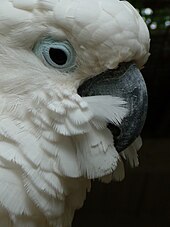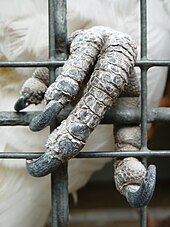White-crested Cockatoo
| White-crested Cockatoo | ||||||||||
|---|---|---|---|---|---|---|---|---|---|---|

Great White-crested Cockatoo ( Cacatua alba ) |
||||||||||
| Systematics | ||||||||||
|
||||||||||
| Scientific name | ||||||||||
| Cacatua alba | ||||||||||
| ( Statius Müller , 1776) |
The White-crested Cockatoo ( Cacatua alba ) is a cockatoo species and belongs to the genus of the actual cockatoos . It is endemic to Halmahera , Bacan and Obi (Obira / Obi Major) in Indonesia .
Appearance
The white-hooded cockatoo reaches a body size of 36 to 45 centimeters. It belongs to the medium to large cockatoo species. A sexual dimorphism does not exist in the plumage, but in the color of the iris in adult animals.
The plumage of the white-crested cockatoo is predominantly white. The wings of the hand and arm are tinged with yellow on the inner flags. The tail feathers on the inside flags are also yellowish. The pure white hood feathers are strikingly large at the end. The beak is relatively large (usually larger in males than females) and greyish black in color. The iris is reddish-brown in adult females, and black-brown to black in adult males and juveniles of both sexes. The toes are gray, the claws black.
Habitat and food
The distribution area of the white-hooded cockatoo are the northern Moluccas. An overlap of the distribution with the Moluccan cockatoo also occurring on the Moluccas does not occur. The climate is typically equatorial and, in addition to year-round high temperatures, is characterized by high humidity. The islands of the distribution area are densely forested. The coasts are dense with mangroves.
The diet of the Moluccan Cockatoo consists of fruits, nuts, seeds, insects and their larvae.
Way of life
The animals prefer to stay in pairs or in groups of three to ten animals. You can find them in mangrove and swamp areas, forests, open forest areas on the tall trees. They can be heard from afar. Your flight is strong, fast, direct, and is accompanied by loud calls.
The breeding season of the White-crested Cockatoo begins in April or May and extends to October, including the nestling period. The clutch usually consists of two eggs, most of which are incubated by the female. The male feeds the female during this time. The breeding season is about 29 to 30 days. The young birds leave the nest box after about 70 days.
status
The White-crested Cockatoo is very rare in the wild. In the IUCN's Red List of Endangered Animals , it has been classified as endangered since the end of 2012 . Loss of stocks through catching for trade and through habitat destruction are to be deplored .
attitude
The keeping of white-crested cockatoos has a very long tradition in Europe. At the beginning of the 13th century, Emperor Friedrich II already had a white-hooded cockatoo. The cockatoo was a gift from the Sultan of Babylon. However, White-crested Cockatoos were first bred in captivity in 1960 by a US owner. The first European breeding succeeded in 1967 in a zoological garden. The first German breeding took place in 1972 with a private owner.
Keeping white-crested cockatoos is demanding. A species-appropriate housing presupposes a paired housing in an aviary that gives the animals sufficient flight opportunities. It is now a legal requirement in Austria and Germany.
supporting documents
Individual evidence
- ↑ http://www.handzahme-papageien.de/index.php?id=47
- ↑ Hoppe, p. 155
- ↑ Hoppe, p. 156
- ↑ Hoppe, p. 156
literature
- Dieter Hoppe : Kakadus - way of life, keeping and breeding , Eugen Ulmer Verlag, Stuttgart 1986, ISBN 3-8001-7155-4
Web links
- Cacatua alba in the endangered Red List species the IUCN 2013. Posted by: BirdLife International, 2013. Accessed January 8, 2014.


